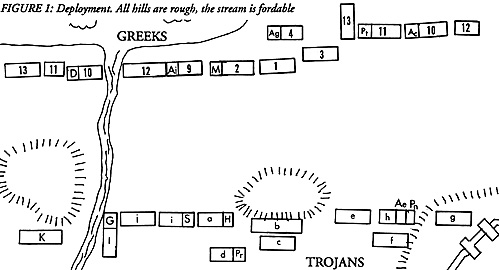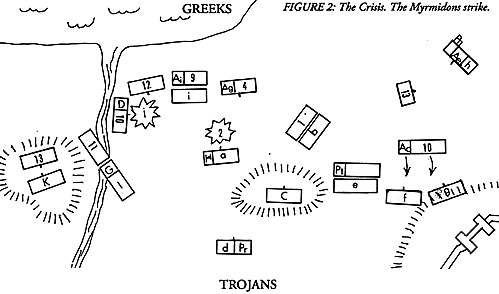The following is a battle report of a demonstration game presented at Historicon this past summer. The rules used were the ultra-simple 'DBA Big Battle', modified to increase the effect of individual 'Heroes'. Each units command element was always considered to be the right front element, regardless of formation changes. A Hero who moved as a chariot but fought as the unit he accompanied, could supercede command by being positioned on a units fight flank, thus becoming the command element in all respects, including the fact that if he gets killed, the unit evaporates.
All elements in a unit commanded by a Hero subtracted the Hero's rating from the scores of opposing elements in melee. One combat factor is very significant in DBA, so that, for example, only Hector has much chance of impeding Achilles, and that not without risk, while if a unit led by Ajax hits a leaderless unit, a massacre would probably ensue regardless of troop type.
The tactical situation is an early example of the classic Hellenic vs. Oriental confrontation, with serried ranks of spears lined up against a widely divergent conglomeration. For the Greeks, there is one command of large units under poltroon commanders, the smaller but more powerful Argolids, and the obvious schwerpunkt of Achilles.
For the Trojans, the Lycians: have excellent troops for use against Spearmen, while the other divisions have a solid core of Spearmen with highly mobile supports. Finally, before each Trojan turn a die was cast -- on a "6" Zeus intervened and gave all Trojan rolls a + 1.
As is generally the case, each side's battle plan was evident from their deployment. The Greek Royal Division intended to press forward to the base of the hill, using their large units to occupy space and reduce enemy mobility, while Achilles smashed the Trojan right. The Trojans planned to press forward with the Lycians in hopes of overwhelming the Greek right and exposing Agamemnon's flank. Against the Myrmidons, the Trojans chose the interesting plan of joining both Aeneas and Penthisilea to their chariot unit (Only one counting as being in command, of course), then sweeping around the flank, blowing away the enemy chariots, and halting Achilles by operating in his rear. If Achilles chose to oppose them by joining his own chariots, then of course the advance of his Spearmen would be little threat. If, however, he could hee his infantry and close, then the absence of the Trojan leaders would clearly be catastrophic.
First blood was shed in the center. The Paeonian archer's caught Agamemnon's bowmen unable to recoil because of awkwardly positioned chariots to their rear, and quickly destroyed them. The Mycenaen spearmen moved in to fill the gap, and a lengthy period of maneuver and shooting developed before the Royal Spears managed to catch and destroy the Paeonians. Menelaus and the Spartans charged the Trojan spears who held, after which Hector, instead of coming up to join his unit, swung around behind it to personally charge and kill Menelaus (This of course made Helen a widow, thus making the whole exercise somewhat moot - great news for Paris who had characteristically spent the entire battle crying on his own baseline)! The Trojan spears then polished off the leaderless Spartans, giving their side the advantage in the center.
To the South, on the left end of the Trojan line, the Lycians were not faring nearly as well. The Greek bowmen shot the warbands up repeatedly, causing few casualties but disorganizing them to the point where they were unable to close, allowing Diomedes to splash across the stream, strike their flank, and annihilate them. Agamemnon and his chariot escort managed to strike Sarpedon, who was already frontally engaged, in the flank and rear and cut him down. The Lycian nobles continued to fight on stubbornly, and though leaderless, were not finally subdued until the days end.
On the Northern flank there was considerably more maneuver. As planned, Aeneas and Penthisilea swept around the flank, blew away a unit of Myrmidon chariots and impeded the advance of Achilles by threatening his rear. Patroclos, though somewhat delayed by his lord's difficulties, made it across the field to hit the Carians. The Carians fought well, even repulsing the initial charge, but it was dear that they could not stand for long.
ORDERS OF BATTLE
TROJANS
ROYAL DIVISION
- Hector (Rating 3) - Tony Crisser
Paris (1)
A. 6 elements Spearmen
B. 8 Bowmen (Paeonians)
C. 4 Auxilia (Aethiopians)
D. 2 Chariots
ACHAEANS
ROYAL DIVISION
- Agamemnon (1) Avram Fleschner
Menelaus (1)
1. 6 Spearmen (Mycenaeans)
2. 6 Spearmen (Spartans)
3. 6 Bowmen
4. 2 Chariots
DARDANIAN DIVISION
- Aeneas (2) Steve Squibb
Queen Penthisilea (2)
E. 6 Spearmen (Carians)
F. 6 Auxilia (Thracians)
G. 4 Auxilia (Thracians)
H. 2 Chariots
ARGOLID DIVISION
- Ajax (3) Paul 'The Achaean' Dobbins
Diomedes (2)
5. 4 Spearmen
6. 4 Spearmen
7. 2 Chariots
8. 6 Bowme
9. 6 Light Infantry
LYCIAN DIVISION
- Sarpedon (2) Kim Kasper
Glaucus (2)
I. 6 Swordsmen (Lycian Nobles)
J. 8 Warband (Lycians)
K. 6 Light Infantry
L 2 Chariots
MYRMIDONS
- Achilles (4)
Patroclos (2)
10. 6 Spearmen (Myrmidons)
11. 4 Spearmen (Pythians)
12. 2 Chariots
13. 2 Chariots
SOME EXPLANATIONS AND APOLOGIES
In the confusion, I misplaced the name of the lady who handled the Myrmidons. I also realize that switching from Greek to Roman names is somewhat 'pidgin mythology', but Ajax just sounds better than Ajas. Finally, I am aware that by the arrival of Penthisilea and the Aethiopians Achilles had already dispatched the shade of Hector off to see the ferryman - let's just say we're following the historical tradition of Herodotus father than Thucidydes. Eventually Achilles managed to work his remaining chariots between his spearmen and Aeneas, freeing up the spearmen under his personal command to join in the attack.
It should be mentioned that while the Greeks always seemed to get plenty of command points, thus being able to maneuver as many units as they wished, the Trojans tended to suffer from a paucity of command points at crucial moments. Of these, Hector tended to be somewhat chintzy in allocating points to Aeneas (understandably, since the Trojans and Lycians were hotly engaged in hand-to-hand fighting), thus causing the chariots to fall away from the Myrmidon rear. This reflects the 'historical' record, in which Aeneas tended to feel slighted for not getting the proper respect or support ftom the sons of Priam. In any case, at the same time that Ajax was finally finishing off the Lycian nobles, and Patroclos was routing the Carians, Achilles crashed into the Thracians and, despite their height advantage, quickly smashed them as well. With both flanks destroyed, Hector had to choice but to concede the day and order the retreat to the citadel.
This was the third time that this event was presented at a convention. In all three outings, games lasted slightly over three hours including set-up and had minimal problems despite the fact that none of the participants had used this system before, and only about half had played DBA or even Ancients. This game also marked the first Greek victory. The course of all three had been somewhat similar, except that in the previous presentations the powerful Lycians had faced off against the Mycenaens/Spartans, and the combination of superior troop types, superior leaders, and superior luck had quickly swept Agamemnon and Menelaus from the field. This time, however, they ran into Ajax and Diomedes, who had proven to be made of sterner stuff.


Back to Table of Contents -- Courier # 59
To Courier List of Issues
To MagWeb Master Magazine List
© Copyright 1992 by The Courier Publishing Company.
This article appears in MagWeb.com (Magazine Web) on the Internet World Wide Web.
Other articles from military history and related magazines are available at http://www.magweb.com